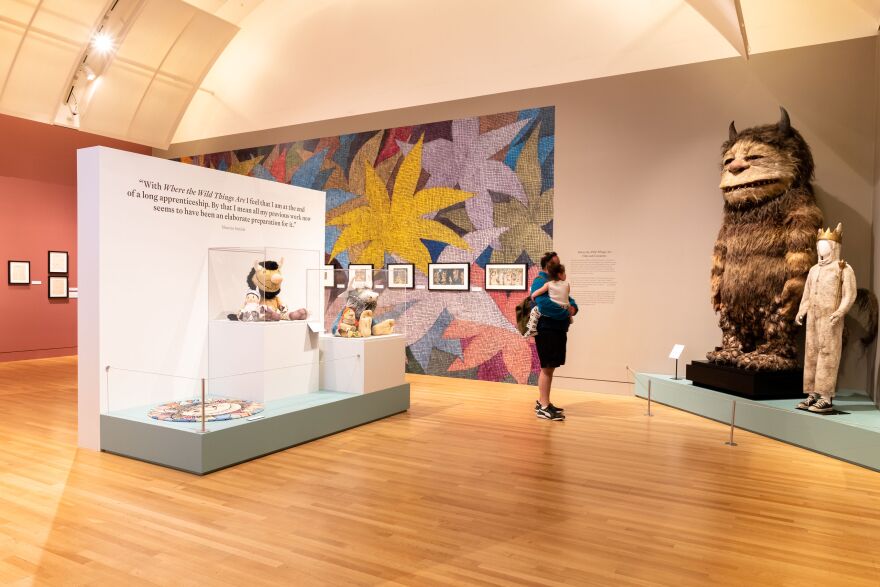Truth matters. Community matters. Your support makes both possible. LAist is one of the few places where news remains independent and free from political and corporate influence. Stand up for truth and for LAist. Make your year-end tax-deductible gift now.
It's where the wild things are! Five things you'll learn at the Maurice Sendak exhibition at Skirball

"Where The Wild Things Are" has sold more than 50 million copies worldwide and has been translated into dozens of languages since it was published in 1963.
The book follows a boy named Max who, after getting into mischief one night, is sent to bed without supper. While he’s cooped up in his room, a forest begins to grow around him. Trees and vines take over, and the walls give way to the outside world. Then, Max hops on a boat and journeys across the sea. When he disembarks, he finds himself in a land of giant beasts, with “terrible claws” and “terrible teeth.”
Now, the children’s classic and its author and illustrator is at the heart of “Wild Things Are Happening: The Art of Maurice Sendak,” an exhibition at the Skirball Cultural Center in West L.A., on view through the start of September.
With over 150 sketches, storyboards, and paintings, it’s the largest collection of Sendak’s work to be exhibited, after his death in 2012. It also solidifies the writer’s role as an artist who continues to shape minds across cultures and generations.
Sarah Daymude, the exhibition’s managing co-curator, said she appreciates that Sendak “never shied away from telling dark or complex stories.”
“Something that a lot of us, even as adults, can learn is that it's ok to talk about difficult things with children. And it's ok to tell these stories, because it's important to validate children's emotions,” she said.
She also loves that the main characters in Sendak's work are always bold, “even though they may be placed in frightening situations.”
Visiting the Skirball
Address: 2701 N. Sepulveda Blvd., Los Angeles, CA 90049
Museum hours:
- Tuesday–Friday, 12:00–5:00 pm
- Saturday–Sunday, 10:00 am–5:00 pm
- closed Mondays and holidays
Admission:
- $18 General
- $13 for Seniors, Full-Time Students, and Children 2-17
- Exhibitions are free for children under 2
Good to know: The Skirball is hosting a Sendak story time every Thursday–Sunday at 3:00 pm
I recently visited this gorgeous exhibition. Here are some of the things you’ll learn there:
ONE: Sendak, a New Yorker who was the son of Jewish immigrants from Poland, had a “desperate loathing” for high school and didn’t do well in class. But he was already a skilled artist: Despite failing physics, his teacher hired him to illustrate a book on the atomic bomb.
TWO: Sendak and his partner, Eugene Glynn, saw their dogs as part of the family. Their dogs made frequent appearances throughout Sendak’s work. To help visitors spot them at the exhibition, Skirball provides a gallery guide that includes cutouts of one of the pups and a sailboat, like the one Max took to see the Wild Things.
THREE: Sendak loved Mickey Mouse, and the Disney character’s big head, big feet, and little body influenced his work.
FOUR: Sendak enjoyed classical music and developed a drawing practice called “fantasy sketches,” in which he’d listen to a piece by Beethoven or Schubert and challenge himself to draw a story that had to be complete before the final note.
FIVE: Sendak also worked as a set designer. At the exhibition, there’s a tiny stage model for the opera “Brundibar,” a nod to Sendak’s time at the Chicago Opera Theater. This opera was also performed by imprisoned Jews at a concentration camp in the Czech Republic in 1943, and nearly every child involved was killed.

BONUS: The exhibition concludes with a living room, complete with comfy couches and a faux fireplace. There, visitors can curl up and read books that Sendak authored and illustrated, as well as books that inspired him.
“I thought it was important to give folks an opportunity to sit and really immerse themselves in the stories,” co-curator Daymude said. When visitors go to museums, she added, they’re often left with a longing to touch and feel the objects, so she and her team made it a point to provide a space for that.
The end of the exhibition also includes a professional drawing desk, with lots of paper and pencils. Daymude wants visitors who are feeling inspired to help themselves to these instruments.
“Who knows? Maybe we'll have the next Maurice Sendaks on our hands,” she said.








